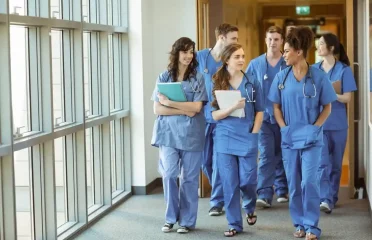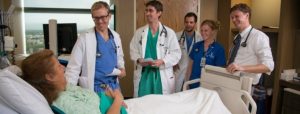What is a typical junior doctors day?
 Group of junior doctors
Group of junior doctors
In the first two (‘foundation’) years, you will do six four-month placements, each in a different department or specialty. They may be in different hospitals.
This article describes a typical day in the life of a junior hospital doctor in the first 5 years-ish (of 10) of further training, after about 5 years at medical school (university). In the second 5 years (of 10), there work may be more like the consultants (‘bosses’, see below).
There is significant variation in the work between specialties, but there are also some common themes that link the majority – and that is what we will focus on here.
The two most notable outliers are if you are working in a Accident and Emergency or in a GP practice.
But for the rest, the broad template is as follows:
1. Morning handover
The day starts off by the night team handing over to the day team.
The doctors who have been working overnight will tell the day team about any patients who have been particularly sick or deteriorated over the night.
They will also highlight any blood tests or scans that have been requested but the results have not come back yet- this is so the day team can keep chase them up.
2. Ward round
The ward round is where the consultant in charge (a.k.a. ‘the boss’; or sometimes his/her deputy called a ‘registrar’) goes round and generally sees every patient under their care.
This is normally done as a team so everyone knows what the plan is for each patient.
Depending on how many patients your team is looking after this can take from under an hour to nearly all day!
On the ward round the consultant will:
- See how the patient feels this morning – are they in pain? Have they been eating and drinking well? Do they have any questions regarding their treatment?
- Check their observations – the nursing staff regularly carry out observations (things like blood pressure, heart rate, oxygen saturations etc) on every patient. These can serve as a useful indicator of how sick someone is. This is the chart at the end of the bed that you see in movies; or in the modern age, the information may be on a computer or tablet
- Examine the patient – examination is a vital skill in a doctor’s toolkit; laying a hand on a patient can reveal a lot more information than numbers from observation charts alone
- Check if there are any tests outstanding – are they waiting for an x-ray or for some blood tests to come back from the lab?
- Decide if any further tests are needed – does the patient need further tests requesting? Do they need more scans or blood tests?
- Consider if the patient’s medication needs changing – do they need any medications added or taken away from their current regime? For example, do they need to start antibiotics for a new infection they have developed while in hospital?
They will then think about the wider plan for the patient – e.g. what is the current aim of treatment? Is the patient awaiting surgery? Do they need the opinion of another specialist? Is the patient well enough to go home? If so, what is the discharge plan? Or should they be kept comfortable in their last days of life? This wider plan is what will steer the direction of treatment for each patient.
3. Do the jobs
So the ward round in essence is the boss going round and deciding on a plan for every patient.
The next step for you as a junior doctor is then to enact that plan!
Important note
Step 3 should not be attempted until you have had lunch (or at least a snack and a coffee) following the ward round.
So, in general, you should make a list of all the jobs that need doing from the ward round; and then try and do them in order of importance with your colleagues.
4. Evening handover
The last thing to do for the day is to handover back to the evening/night team.
There are far fewer doctors on overnight compared with over the day so the aim is to only hand over the essentials.
Much like the morning handover but in reverse, you will highlight any patients that have been particularly sick over the day (in case they get worse overnight) and any blood tests or scans to keep an eye out for.
Summary
We have described what is a typical junior doctors day. We hope you understand it better now.
Last Reviewed on 10 March 2024

